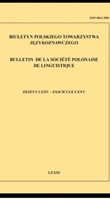Kontakt językowy w tłumaczeniu. Początkowy etap rozwoju przedimka określonego w świetle gockiego przekładu Biblii
Language contact in translation: The initial stage in the development of the definite article in the light of the Gothic text of the Bible
Author(s): KAZIMIERZ A. SROKASubject(s): Historical Linguistics, Sociolinguistics, Biblical studies, Translation Studies
Published by: Polskie Towarzystwo Językoznawcze
Keywords: determination; definiteness (its formatives; functives; and formal values); determiner; article; actual scope value of a name;
Summary/Abstract: Definiteness (weak determination) is a characteristic of grammatical constructions whose base is a name, and whose formative is an article (a weak determiner). In definiteness, there are exponents (which are formatives of such grammatical constructions), e.g. the, a(n), functives (or determinants), and formal values (viz. definite, indefinite, and bare). Functives are the factors which, at the stage of encoding, determine the occurrence of particular exponents. They are either formal (e.g. the target role of the article as an exponent of nominalization) or logico-semantic. The latter make a system whose components are the actual scope values of a common count name, viz. α1 = unique, α2 = identifying, β = free, γ1 = universal, γ2 = existential, and δ = species-oriented. They correspond to the subsets of the scope of the name which, at the stage of encoding, are those to be conveyed in the message, and, at the stage of decoding, are recognized as actually conveyed. The types of functives just defined are applied to the analysis of the use of the simple demonstrative sa (m.), sō (f.), þata (n.) ‘this, that’ in the Gothic translation of the Bible. It is shown that this demonstrative can be qualified as an article or article-like determiner when it appears as (a) an exponent of co-reference, i.e. when the actual scope value of the name it precedes is α2 (identifying), e.g. hundafaþs ... sa hundafaþs ‘a centurion ... the centurion’, (b) an exponent of nominalization, e.g. sa saiands ‘the (one) sowing’, ‘the sower’, and (c) an element connecting the components of an appositive construction, e.g. sunus meins sa liuba ‘my son the beloved (one)’. Such types of the use of the demonstrative are treated as the initial stage in the development of the definite article in Gothic. It is probable that in a similar way, and especially as an exponent of co-reference, this article started to develop also in other languages. The influence of the Greek original upon the use of the Gothic simple demonstrative as a counterpart of the definite article ὁ, ἡ, τό is indubitable but it is not so strong as to violate the morphosemantic rules of Gothic. Thus, in the case of the actual scope value α1 (unique) and γ1 (universal), a simple name in Gothic is preceded by the zero determiner although (but not always) in the Greek original it is accompanied by the definite article, e.g. in the case of α1 : sauil ὁ ἥλιοϛ ‘the sun’, and in the case of γ1 : skalks ὁ δοῦλος ‘the servant’.
Journal: Biuletyn Polskiego Towarzystwa Językoznawczego
- Issue Year: LXXV/2019
- Issue No: 75
- Page Range: 141-163
- Page Count: 23
- Language: Polish

